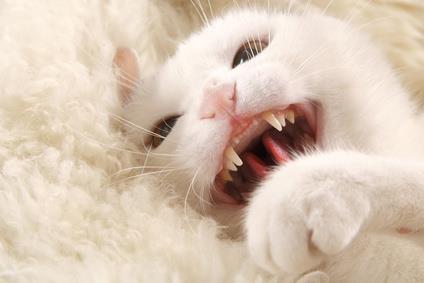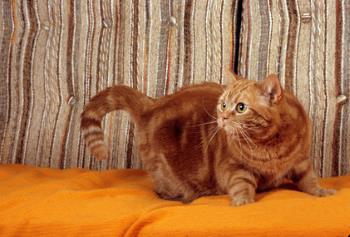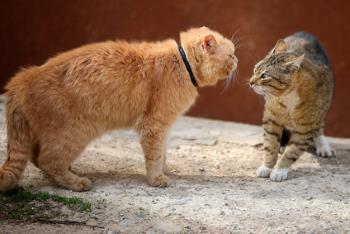Living with an aggressive cat is not easy. No one likes getting scratched, bitten or even threatened. Whether or not you already know why your cat attacks you or other cats, you can avoid these experiences by understanding cat body language–especially the signs of approaching aggression.

In this article, you will learn about cat body language, vocal signs of offensive and defensive aggression in cats and how to recognize an aroused cat.
Signs of defensive aggression and irritation in cats
Defensive aggression is more common than offensive aggression in cats. Defensive aggression happens when a cat tries to avoid, scare away or interrupt the person threatening him or her. In a household situation, it is commonly directed towards people, other cats or dogs.

When a threat approaches, a cat is likely to assume one of two strategies. The feline can try to appear as small as possible, unconsciously signaling he or she is not dangerous. Or the cat may try to scare the opponent away by pretending to be larger and more dangerous. In both cases, the cat will retreat if possible but can launch a counter-attack if a threat intensifies. Here are some examples of defensive aggression:
- Tail lashing or twitching is the most prominent sign of a cat showing dislike. Cats use their tail for communication all the time. Keep an eye on your cat’s tail when interacting with him or her. If you see it twitching, be mindful of your actions. If a cat is fearful, his or her tail may be stiff in an inverted “U” shape or wrapped around the body. Learn more about fear in cats here.
- Ears and whiskers folded backwards. Whiskers and ears are tools to gather information. In case of a threat, a defensive cat may fold them to prevent damage and decrease the amount of stimuli received. The degree to which ears and whiskers are folded can signal intensity of fear or defensiveness.
- Eyes squinted or wide open. Depending on the situation, cats may squint or close their eyes to avoid outside stimuli and prevent eye contact. Just as often, cats respond to fear by opening their eyes as wide as they can to gather more information about the threat. You may noticed that people react to fear in these ways, too.
- Skin twitching, especially if you are about to touch your cat, is thought to be an avoidance sign, such as trying to escape the touch.
- Low crouching posture. This is usually accompanied with legs drawn under the body and the tail wrapped around it. The cat may face the threat laterally, allowing for a quick escape if needed. The signs mentioned above may also be present. The body posture signals the cat is small and poses no threat to the intruder. If you pay close attention, you will see one of the front legs pointed away from the threat, facilitating a potential escape.
- Arched back, piloerection, lateral position. This posture is also known as a “Halloween cat”. It is a defensive signal cats use to appear larger than they are. Lateral position is assumed so the opponent can estimate his or her size and to enable an escape when the opportunity comes.
- Growling, hissing, spitting, snarling. These vocalizations tell the threat to back away. Defensive cats are usually more vocal than offensive ones for a simple reason: an attacker wants to keep his or her intentions discreet for as long as possible. Thus, he or she is silent. The victim, however, must be vocal to scare the opponent away. Hissing, for example, is an automated defensive response to a sudden fright. It has a startling effect to anyone who hears it.
If you notice any defensive aggression signs in your cat, your best strategy is to leave him or her alone if possible.
Signs of offensive aggression and arousal in cats

Offensive aggression is usually observed with a cat being territoriality aggressive towards another cat or when a cat redirects his or her prey towards human body parts. Signs of offensive aggression are less pronounced, but they can be identified as arousal and determination:
- Wide eyes, fixated look. If a cat is about to attack, he or she is likely to keep eyes on the target. The head may be lowered, and the cat may also slowly approach the target. This is a great opportunity to redirect the cat’s attention–for example, to a toy.
- Ears and whiskers stretched forwards. This signals high alertness. Ears and whiskers help gather information, which is equally important as vision is for us. Cats may pay increased attention to normally insignificant noises and movements of objects or other pets. They may appear nervous when alerted.
- Slow but steady approach to the target. The cat may also be crouching low to the ground. Alternatively, a faster approach with determined pace can be taken. Seconds before a pounce, a cat may tread with his or her front and hind legs in place as if trying to aim for the best moment to attack.
- Hair standing on the body and tail. This can be considered a passively offensive aggression. The cat is initiating the aggression, but his or her initial goal is to intimidate and scare the opponent rather than attack. This is often seen in territorial attacks, which usually involve exaggerated threats.
- Tail waving. Contrary to the necessity of remaining unnoticed, an aroused cat can graciously wave his or her tail while hunting and when aroused. The tail may also be twitching and quivering before an attack, signaling agitation. Repetitive tail waving is also thought to help reduce stress.
- Vocalization is limited. In most cases, there is no vocalization if a cat is offensively aggressive. Some growling may be present if the bully and victim are aware of each other.
These offensive and defensive signs of cat aggression must be assessed by looking at the whole body. Each individual sign can mean several things, and their true meaning can only be gaged when other signs are present. Knowing how to interpret your cat’s body language can literally save your skin; just before the attack is launched, you can change the course of action.
While the strategy for avoiding aggression can ensure peace, it does not address the underlying causes of the aggression, whether it’s fear, pain, territorial conflict or stress. In future articles, you will learn how to deal with different cat aggression types. Involving a veterinarian or professional behaviorist is highly recommended.
